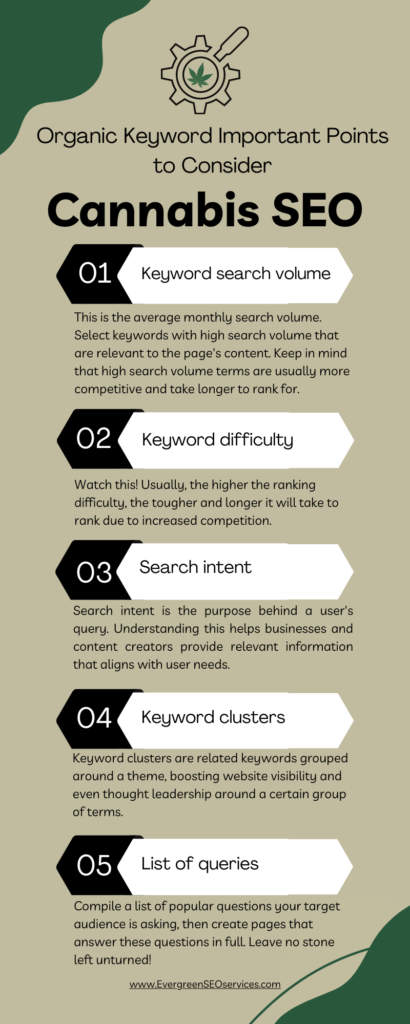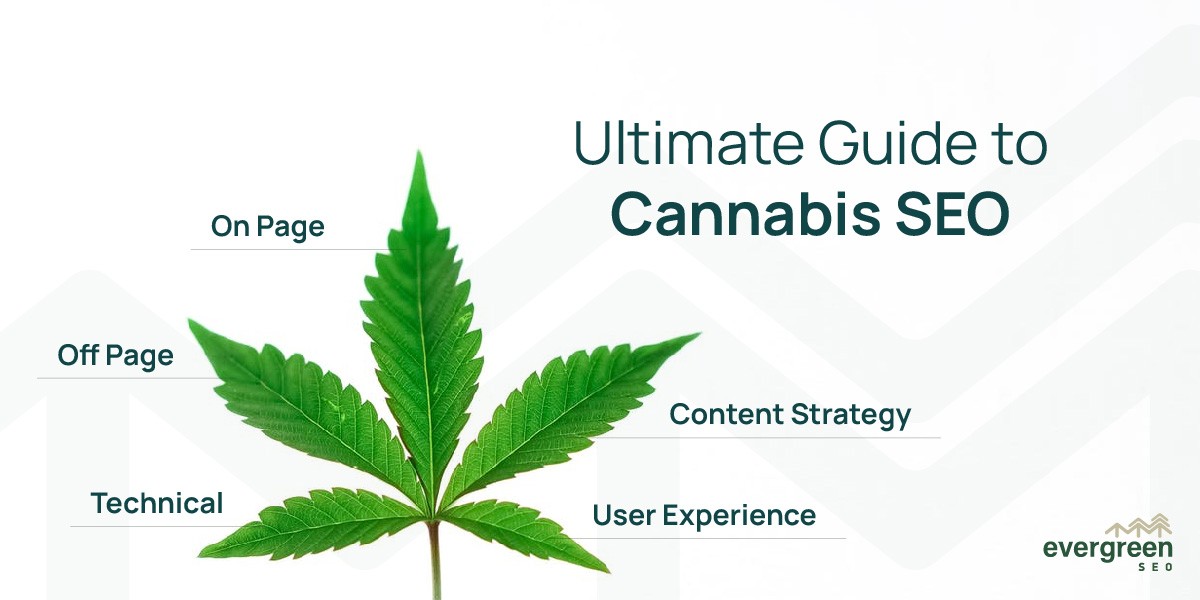In recent years, we’ve seen a boom in business within the cannabis market, and it won’t stop any time soon. According to forecasting reports, the cannabis market is expected to be worth around $176 billion in 2030 due to rapidly accelerating legalization efforts across the United States. Due to this increased growth, now is the perfect time to optimize your marketing strategies through cannabis SEO.
There’s nothing more effective than investing in an SEO strategy to increase your reach and target more potential customers. In this article, we’ll discuss the basics of what cannabis SEO is, why it’s important, and share practical tips on planning content. This includes what to focus on when creating your SEO strategy and more, so keep reading and let us help bring your business to the next level with an informed cannabis SEO strategy.
What Is SEO and How Does It Work?
Cannabis search engine optimization, or SEO in general, is a set of practices that help a website gain organic traffic and rank higher in the search engine results pages (SERPs). Compared to SEM (search engine marketing) which is paid marketing, SEO refers to the organic reach of potential customers acquired through content.
The way that search engines decide the ranking of a site is through using bots that “crawl” pages on the web and index them together with all the information on the site. The indexes are then analyzed and a number of ranking factors are taken into consideration during this process. Finally, the algorithms decide which pages appear first as search results for a certain query based on this analysis.
The reason you want to rank higher on search engines is that Internet users almost exclusively reference the first page, even the first 2-3 listings, of a SERP (search engine results page) in order to find relevant information. So, having a good cannabis SEO strategy means more prospective customers visiting your site.
If you’re not convinced yet, here’s another reason why investing in cannabis SEO is a good business decision.
Why Do You Need Cannabis SEO?
While SEM is a good method to acquire a top-ranking spot on a search engine, this type of paid marketing isn’t currently available for the cannabis business due to regulatory restrictions. This is because cannabis is still illegal in a lot of countries all over the world, as well as in the US on a federal level. As a result, cannabis companies are barred from using Google Ads as well as traditional forms of media, such as TV, radio, and more. There are very few Google Ads cannabis businesses can utilize, but not nearly at the level of traditional businesses. Due to these obstacles, all that’s left is reaching customers organically through SEO, which is the most efficient way cannabis companies increase brand awareness and acquire new customers.
As the cannabis market continues to expand, more and more companies are vying for top rankings. A superior SEO strategy is necessary when your business is competing with other companies both locally and across the country.
But what types of SEO are there and why is each so important?
Types of Cannabis SEO
SEO can be divided into three main categories:
On-page SEO
On-page SEO refers to all of the various elements that appear on a certain webpage such as the title, keywords, UX, headings, and meta descriptions that search engines check for relevance when ranking your pages.
Off-page SEO
Off-page SEO involves all things happening off of your website such as backlinks from other sites pointing to your website, as well as all other marketing tactics such as billboards, sponsorships, display ads and similar. The links help to validate your site’s expertise and authority on a particular subject, and all of the other channels help push traffic to your site, as well as increase your branded search traffic.
Technical SEO
Technical SEO is the way that your site is developed, whether it’s crawler friendly, load speed, javascript, CSS rendering, and more.
Now that you know the basic SEO categories, let’s see how you can use SEO to improve your rankings.
Best Cannabis SEO Practices to Improve Your Rankings
It’s important to note that successful SEO cannot be achieved without keyword research and high-quality written content, so let’s take a look at how to incorporate these strategies into your site.
The Importance of Keyword Research vs Search Queries
While search engines don’t currently allow cannabis ads, they do allow search queries about cannabis, and this is where the most important aspect of SEO comes to light: keyword research. By implementing adequate and relevant keywords in your content, you can increase the value of your content and capture more search demand to your website.
Capturing Demand vs Creating It
It’s important to quickly mention here that SEO as a channel is about capturing demand, not creating it. When I’m creating a strategy for a business, I’m trying to help them get in front of the searches that are already happening, capture the traffic and bring it to the site.
This is the opposite of advertising. In advertising, the main goal is to figure out where your target audience is, and then place ads in front of them where they’ll see it. With SEO, our goal is to find out what our target audience is searching for online, then get a page to rank well enough so that they find it and visit it to get their answer.
Important Factors for Keyword Research
When drafting an SEO strategy, finding relevant keywords that answer the most searched queries will be the key to your success. However, this is easier said than done as a lot of other businesses are also trying to rank for the same keywords. When determining the right keywords, it’s most important to think about your target audience, as well as your business’s overall topic.
- Audience – WHO is it specifically you are trying to reach, and what are they likely to search for? Don’t just think about the products/services they may search for, also think about what questions they have and how you can best answer them.
- Topic – what is your company’s overall topic? A dispensaries main topic would be cannabis, cannabis products, education around them, and top brands, while a cultivator’s topic would still be on cannabis, but more focused on the specific strains they cultivate, as well as cultivation in general. If you are a niche cannabis business such as a cannabinoid emulsion provider, your focus would be more on the products your emulsions help brands create, as well as the market for those product types and similar. In this example, the search volume would likely be smaller when compared to a dispensary, but its relevance over volume all day long. Let’s talk more about these things…
When searching for potential keywords, you should keep the following factors in mind:

- Keyword search volume. This refers to the average number of people that search for a given term each month. While it’s typically ideal to choose keywords with higher search volume, it’s more important to be relevant to your topic and the search intent behind the keyword. Sometimes this means choosing smaller search volume terms to ensure your page attracts relevant traffic. Relevance > Traffic
- Keyword difficulty. The higher the search volume of the keyword, the more difficult it will be to rank for it due to the amount of competition. For example, the keyword “CBD gummies” is an extremely competitive keyword with over 35,000 monthly searches, so you shouldn’t expect to rank well for it overnight. Set the expectation with your marketing team or leadership that terms like these will take 3-6 months, if not longer to rank for, depending on the quality and authority of your page and website overall.
- Search intent. The goal is for the person who clicks on your site to find the information they’ve been looking for. Your SEO strategy should contain both short-tail and long-tail keywords with a particular focus on fulfilling the user intent by answering their question completely. Don’t let the user leave your page feeling like they don’t have the full version of the answer they are seeking.
- Keyword clusters. Create clusters of keywords that have similar search intent to improve your ranking chances. An example using “edibles” as a topic cluster would be:
- 5 Best Edible Brands in [Your State]
- How to Consume Cannabis Edibles and What to Know about Their Effects
- Types of Edibles and How Fast They Take to Work
- What to Do if You’ve Taken Too Many Edibles
- How to Make Cannabis Edibles: A Beginners Guide
- Edibles Cannabis vs Smoking: What to Know and the Main Differences
- List of queries. It’s important to know what your audience is “asking” search engines (aka Googling) when you plan your SEO strategy. You want to be able to get in front of potential buyers to answer these questions in their moment of need. To make your list, there are a number of tools you can use such as Semrush, Ahrefs, Answer the Public, and more to compile a list of these questions.
Content Marketing for Cannabis Companies: Write Content That Ranks
We can’t fully develop an SEO strategy without a content strategy. When it comes to your website, content refers to the copy on your landing pages as well as any blogs. Essentially, content refers to any form of written words, video and similar. Once you’ve decided which keywords work the best for your business, you can start building content around those keywords. For example, if your business focuses on cannabis concentrates, you can begin building informational, educational blogs about cannabis concentrates while organically incorporating your target keywords.
After you’ve chosen your relevant keywords, it’s time to start creating your content. The goal for your content strategy should be to create main articles and supporting articles that provide additional information that’s connected to the main article. It’s a good rule of thumb to create at least 3 to 5 supporting articles for every main article.
For example, if your main article is titled “The Benefits of THC”, your supporting articles could be titled:
- Can THC help with pain?
- Is THC good for anxiety?
- The difference between THC and CBD
- What is the appropriate dose of THC for me?
- Can I consume too much THC?
The Significance of Technical SEO
Technical cannabis SEO is foundational to your site’s success, by focusing on technical aspects of your site to increase its search-ability and user experience, as website speed, mobile responsiveness, website architecture, overall design, and indexing play a big factor in rankings. Technical cannabis SEO ensures that search engines can crawl and index your website effectively, leading to better rankings and visibility overall. If you’re serious about boosting your website’s rankings, investing in technical SEO is critical to achieving long-term success in your SEO efforts.
Here are some essential SEO tips to consider when assessing your business’s website:
- Tailor the content to your audience. Remember who you’re writing for and keep it relevant to the search intent, while being informative and interesting to read.
- Focus on the headlines. The headlines are the first elements that pique the interest of the reader, so make sure that they’re compelling, to the point, and keyword-rich.
- Focus on keyword-rich phrases. As we’ve mentioned above, including relevant keywords is essential for creating good SEO content and informing both your readers and the search engines what your content is about. Just be careful not to overuse any keywords, as this can have some negative consequences. Use keywords naturally.
- Write articles with a clear structure. Another way to achieve SEO and reader-friendly articles is by using a proper tag hierarchy (the titles should be H1, subtitles H2, and so on), shorter paragraphs, and bullet points so that the articles have a clear structure and are easy to digest.
- Include relevant images. Making your posts more visual by adding relevant images is another way to make them more attractive and reader-friendly.
- The importance of link building. Finally, interlinking your articles is essential to getting a higher rank on the SERPs and keeping your readers engaged.
Link Building with Other Websites
Link Building is an important component of SEO that involves getting other websites to link back to your site. By building links with other cannabis websites, you can improve your website’s authority and visibility within the cannabis industry. One effective way to build links is through guest posting, where you create content for other cannabis websites in exchange for a link back to your site.
Link Building isn’t only a means to foster authority, it’s also a way to provide your visitors with credible sources and creates relationships and collaborations within the industry. It’s important to engage in ethical link-building practices, so avoiding link farms and irrelevant link exchanges is necessary to truly develop an authentic and successful link-building strategy.
Additional Cannabis SEO Tips
Since we’ve covered the basics of cannabis SEO, let’s go over some additional tips and tricks that will help your cannabis SEO strategy.
Analyze the Current Search Traffic
Before you start planning your SEO strategy, it may be beneficial to audit the current standing of your site. You can do this by analyzing your website’s Google Analytics account and Google Search Console. Once you’re there, you can see what your most popular pages are and what these pages have in common. While in Google Search Console, look up common search terms for your business and see where they land in the SERP. Once you have a better understanding, add those links.
Whether it is the length, the quality, or the on-page optimization of the posts, the information gathered from your site’s analytics will help you plan your SEO strategy for your cannabis business.
Focus on Search Intent
Knowing how cannabis consumers search the Internet will give you a lot of information when planning your SEO content. When typing a query, cannabis consumers do one of these four types of searches:
- Navigational searches look for a specific site or application.
- Informational searches seek an answer to a question and in this case, Internet users mostly rely on the title tags and the meta descriptions.
- Commercial searches are those looking for a particular product to buy while reviewing a number of brands.
- Transactional searches refer to searching for a specific product from a specific brand.
Matching content with the user intent is extremely important both for satisfying the query intent and also because you’re more likely to make a sale if the person who comes across your page easily finds what they’re looking for there.
As a result of the BERT (Bidirectional Encoder Representations from Transformers) update, Google is now even better at determining user intent. This algorithm combines natural language processing (NLP) and machine learning (ML) in order to provide the best page for the query. Thus, making sure that your post provides all the necessary information for a particular query is essential.
Mobile Optimization
As of February 2023, 52.08% of total web visits are currently performed on mobile according to Oberlo Statistics, so it’s absolutely essential that your site is optimized for mobile as well as for desktop. Recently, Google started to rank differently on mobile and desktop, so you may notice that a page ranks on top for desktop, but is on the second SERP on mobile.
The biggest reason why mobile and desktop searches differ is that the former are often done in a hurry, so if your site loads slowly on mobile, it will rank lower regardless of your keyword strategy. Since 2019, Google has been focusing on mobile indexing in order to provide the best experience for Internet users, so sites that aren’t mobile-friendly won’t show up on mobile phone searches.
Extra Optimization and User Experience
To keep your customers coming back to your site, you need to make it user-friendly. In order to enhance the user experience, you may want to:
- Make your website easy to navigate with a clear hierarchy and intuitive menu.
- Create compelling headlines and meta descriptions that accurately reflect the content of each page.
- Include internal linking to help users discover related content on your website.
- Consistently monitor and analyze user behavior data to identify areas for improvement and make data-driven decisions.
- Use subheadings to make the text easier to read but also easier to understand when Google is analyzing it.
- Add relevant images, videos, graphs, and other content that illustrates your points.
- Use margins, a nice font, and place the most important information in bold to increase reader comprehension.
- Avoid popups and if you do decide to use them, add them as exit-intent popups.
Optimize Favicons
Another way to distinguish your brand from others on the market is by including a well-designed favicon that signals to the user that this is the brand they’re looking for. Favicons are icons associated with a URL that appear often on a website. Favicons are not only beneficial for user experience, but they make a site look polished and professional.
Include Keywords in Your URL
A strong URL is a great way to improve the rank of your site. The URL should be short, contain an industry keyword, and it shouldn’t contain any numbers or symbols. Just make sure that it’s easy to read and relates to what your site is about, if you need help, use Google Simple URL.
Title Tags
The title tags are another crucial element as they give information about the content and get the reader’s attention. The best SEO titles contain between 50 to 60 characters and include target keywords, numbers, and match the search intent to the title tag.
Meta Descriptions
The meta description is the paragraph that appears beneath the title tag and describes the page in just a few words. Make sure that it’s well-written in order to compel the reader to click. Similar to title tags, the meta description should contain relevant keywords and should be under 160 characters. Note that meta descriptions need to match search intent or Google might pick a meta description based on the content on the page itself.
Content Audit and Relaunch
Finally, the content you add to your site should always be updated and current. Keep in mind that as time passes, the content becomes stale. It’s a good idea to relaunch old content throughout the year. Once you’ve updated content with new information, it maintains relevancy.
Tailoring the Cannabis SEO Strategy to Your Business Model
Not every SEO strategy will be equally successful for different businesses. There will be a huge difference between an SEO strategy for a dispensary, a CBD company, and a multi-state operator. This is largely due to the reach of the organization, who they’re targeting, and what the ultimate goal of their strategy is. For example, the strategy will be different if you’re looking to get customers in your store, versus a strategy meant to boost traffic to your blog.
Dispensaries
Dispensaries are retail stores, meaning they generally focus on building an SEO strategy that is local and tied to the location where the dispensary is situated.
CBD companies
A CBD wellness company often plans for national SEO strategies as CBD has been legalized in the US on a federal level if it contains less than 0.3% THC, meaning that their target is nationwide versus hyper-local.
Multi-state operators
These large corporations focus their SEO strategies on the states that they ship to and operate from.
Partner with an Experienced Cannabis SEO Agency
Learning about cannabis SEO may seem confusing or overwhelming, but as a cannabis business owner you need to make the best decisions for your business and this certainly includes a cannabis SEO marketing strategy. By hiring professionals that specialize in cannabis SEO, they can help you navigate the unique challenges and opportunities present in the cannabis industry.
Expert guidance on keyword research, content creation, on-page optimization, and link building is invaluable when you are trying to increase the visibility of your site and convert visitors to loyal customers. Additionally, SEO agencies can help you stay current on the latest search engine algorithm updates and best practices. Reputable cannabis SEO agencies will ultimately help improve your online visibility, drive more targeted traffic to your site, growing your business overall.
Getting results from SEO can be a game changer for your business. Getting it right the first time by partnering with a credible, trusted, and knowledgeable agency like Evergreen SEO can help you reach your online goals while navigating any obstacles presented by the ever-changing regulatory landscape, consumer trends, and algorithm changes. If you want even more information on how to choose an SEO partner, check out our post “What to Look for in a Cannabis Digital Marketing Partner”.
Final Thoughts on Cannabis SEO
Even though there is a lot to keep in mind when creating an SEO strategy for your cannabis brand, we hope this article has given you the essential information you need to bring your business to the next level. By following a few simple steps, you’ll be on your way to creating a powerful cannabis SEO strategy that has a high potential to separate you from your competition.
Still wondering how hiring an agency can help you achieve your cannabis business’s online goals? Set up your free SEO analysis with Evergreen SEO today and we’ll guide you through the process.





